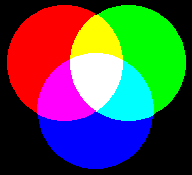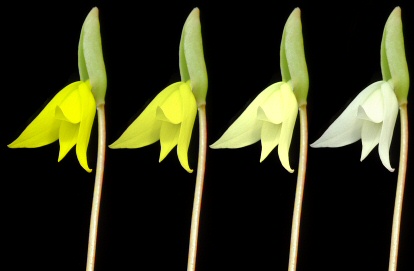What is color?
 Visible light, although occupying only a tiny range of the electromagnetic spectrum, is of particular interest for
two reasons. First, our sun emits most of its electromagnetic radiation in the visible wavelengths. Second, while our atmosphere
blocks many forms of radiation, it does not impede visible radiation. As a result of these two effects, the daylight surface of the
Earth is bombarded with visible radiation. Organisms on the Earth's surface have exploited this by evolving sophisticated radiation-sensitive
sensory organs (for example, eyes). Eyes are very sophisticated--they produce accurate, high resolution images at a wide range of
illumination levels. The eyes of many organisms, humans included, can distinguish photons of different wavelengths within the visible
light range. (Specifically, human eyes perform three-band multispectral photometry.) The different wavelengths in this range are called
"colors." Ordered from long to short wavelengths, these colors are red, orange, yellow, green, blue, indigo, and violet,
remembered with the peculiar mnemonic "Roy G. Biv."
Visible light, although occupying only a tiny range of the electromagnetic spectrum, is of particular interest for
two reasons. First, our sun emits most of its electromagnetic radiation in the visible wavelengths. Second, while our atmosphere
blocks many forms of radiation, it does not impede visible radiation. As a result of these two effects, the daylight surface of the
Earth is bombarded with visible radiation. Organisms on the Earth's surface have exploited this by evolving sophisticated radiation-sensitive
sensory organs (for example, eyes). Eyes are very sophisticated--they produce accurate, high resolution images at a wide range of
illumination levels. The eyes of many organisms, humans included, can distinguish photons of different wavelengths within the visible
light range. (Specifically, human eyes perform three-band multispectral photometry.) The different wavelengths in this range are called
"colors." Ordered from long to short wavelengths, these colors are red, orange, yellow, green, blue, indigo, and violet,
remembered with the peculiar mnemonic "Roy G. Biv."The human eye-brain system responds in a peculiar way when it simultaneously detects photons of different colors. For example, if the eye receives red and green photons simultaneously, it reports that it is detecting "yellow." Only by analysis with a more reliable piece of equipment can a careful researcher determine if the "yellow" being detected is a result of a beam of yellow-wavelength photons, or a beam containing both red photons and green photons.
If the human eye is bombarded with a crowd of diverse photons with wavelengths sampling all the colors ROYGBIV, the overworked eyeball-brain system reports the detection of "white light." Conversely, "black" is the signal reported to indicate the lack of photon detection. The concepts of "white" and "black" are artifacts of our eye-brain's light sensing and interpretation limitations and do not have much in the way of counterparts in the real universe.
 It is useful for the student of remote sensing to ponder color further. Consider white lilies in a field. These flowers are
highly reflective at all optical wavelengths. As such, they reflect all the light that strikes them, and when they are illuminated by
"white" sunlight, they appear "white" to our eyes. Now, consider a yellow lily. This flower may appear yellow for one
of several reasons.
It is useful for the student of remote sensing to ponder color further. Consider white lilies in a field. These flowers are
highly reflective at all optical wavelengths. As such, they reflect all the light that strikes them, and when they are illuminated by
"white" sunlight, they appear "white" to our eyes. Now, consider a yellow lily. This flower may appear yellow for one
of several reasons.
- First, it may absorb all optical photons that strike it except for those with yellow wavelengths, which it reflects with vigor. This would result in an yellow flower.
- Second, it may absorb nearly all optical photons (including yellow), and reflects only red and green wavelengths. This would result in an yellow flower.
- Third, it may reflect all optical photons, with the exception of blue photons. This would result in an yellow flower.
For reasons of completeness, I am compelled to note that even a flower that uniformly reflects all colors equally (i.e. a "white" flower) would appear yellow if illuminated by a yellow beam of light.


